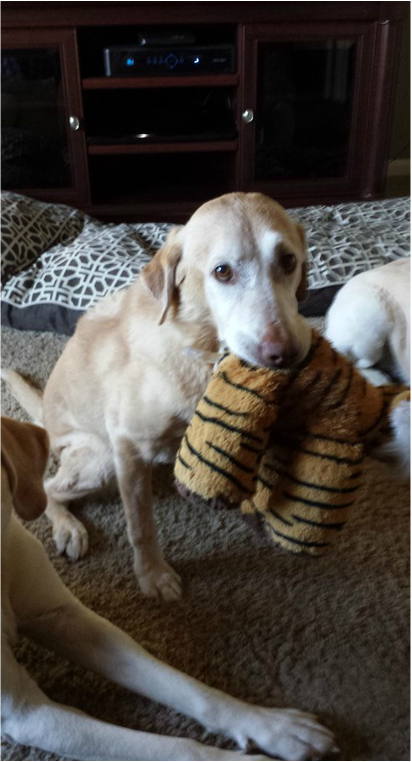|
This week has been a tough one at the Arneson household, as our eldest Lab, M.E., passed away after 13 1/2 love-filled years. I won't lie. The first few weeks, even months (okay, if I'm totally honest, it might have been the first two years) were really rough. M.E. was a nervous pup---unpredictable, didn't warm to new people, and had to carry around a toy in her mouth like a pacifier. Well, now, you can see the toy-carrying behavior never changed. This picture was taken this year.
After our first Lab, K.C., passed away in 2008, I wrote a book called "Letting Go of K.C." that talked about how much Dave and I learned about co-parenting such a great Labrador Retriever. M.E. will likely not get a book written in her honor, but I thought it appropriate to talk about the lessons she has taught me and how they relate to education and life, in general. Non-verbal language is still language: M.E. may or may not have pottied on the floor once or twice, out of nervous anxiety about some unknown entity (I say she stared at walls and saw things in them. Dave says, "Don't talk about M.E. like that".) The nice part about that behavior, if there was one, is that M.E. would come in the room and tell on herself. How do we know that? She would come sit right by us, with a toy in her mouth, whine like a baby, and look in the general direction of the "mess". We just had to be smart enough to read her cues. It is the same thing with people we love and with whom we work. I have watched parents in IEP meetings, or teachers in grade level meetings, get frustrated and, if someone didn't recognize the look of frustration, the meeting could have gone downhill quicker than a bobsled on a snowy mountain. We need to communicate, not only verbally but non-verbally, as well. I talk to my graduate classes whom I teach to listen attentively to one another. That includes what is said and what is "read". Everyone needs to feel needed: While M.E. was slow to warm up to strangers, it was not that way with fetching the newspaper. We had only to open the front door, and she would run like the wind to the newspaper at the end of the driveway, pick it up, and run back in to the house. Proud as a peacock, I might add. Why? She had a purpose. I have often talked about moving to Florida and visiting an Episcopal church (just to visit, mind you), and the priest came up after the service, introduced himself, and said, "One of the parishioners said you had a beautiful voice. Would you like to join us for choir practice this Wednesday night at 6:30?" Simple as that, I was needed. A word of caution: by week 3, I had become a youth group leader, as well, as "one of the parishioners said you were a middle school counselor. We need a middle school youth group leader. Could you help us out?" My point? If people feel needed, I believe our schools are like this. Staff members need to feel needed. They need to feel a sense of belonging that, sometimes, comes only by believing they can rise to the challenge of taking care of a task. One of my dearest staff members (EVER!) wasn't positive she could tackle a task I asked of her...until she did it and was amazed at the results. Her confidence rose and she began taking on new responsibilities and volunteering for so much more than we ever bargained for. Our students are exactly the same way, right? If Anthony is tardy every single morning, and we say to Anthony, "Hey, you are so good with computers. I am wondering if I could get you to come in a few minutes early each day to help me turn on and troubleshoot the computers in this area?", I am betting some pretty good dough Anthony begins to at least try to get to school each day (if, and only if, you have built a relationship with him). When we are loved, we are at peace: Dave and I have made a deal. No matter what...we want to be there when our dogs pass over the Rainbow Bridge. We know fully well that might not always happen, but when we took M.E. in to the vet (her back end would no longer allow her to walk anymore) to put her to sleep, we both held her, stroked her caramel-coat fur, prayed with her, and kissed her liver-nose while the vet did what he needed to do. Our typically hyperactive Lab gazed into our eyes with her chocolate-brown eyes and was at total peace. In our workplaces, we will encounter people who will freak out. It will sometimes be about feeling overwhelmed with all the demands of teaching (the test materials are incorrectly printed, we have a lockdown and one of my students just left for the restroom, etc.). Other times, the tension might be due to other, outside issues (divorce, death of a loved one, etc.). The most calming factor we can provide is care, concern, and love. I am not suggesting we either pet one another or have a vet prepare an injection, but instead I mean to say that we should not be afraid to show love to those with whom we work. Losing a loved one is tough business. But I am forever grateful for the time we had with M.E. and the lessons she shared with us throughout her quirky existence. Just for today, perhaps we can look at what our pets are trying to tell us and teach us. Happy Communicating! Shelly
0 Comments
Leave a Reply. |
Shelly ArnesonCategories |



 RSS Feed
RSS Feed